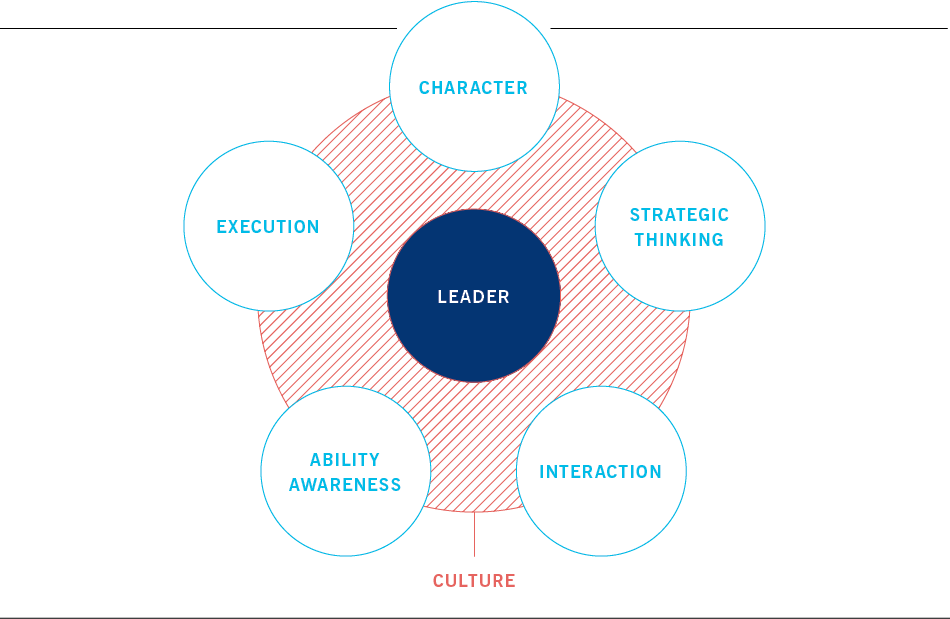A Leadership Model
Few things inspire our passions like sports. While fans often disagree about the best team or the best players, almost everyone has a favorite. Sports provide unmatched drama and, for both players and fans, invaluable life lessons.
For players, those lessons may center on teamwork, how to be a good winner or loser, and how to focus to achieve goals. As fans, we learn loyalty, patience (if you’re a Cubs fan), and more than a few lessons from the best and worst behavior of the players on our favorite teams.
Sports coaches offer additional lessons around leadership that also apply to business. What makes someone a great coach? What habits or skills do they possess that enable them to quickly turn around a struggling team? How do they move a team from “good” to “great”? How do they sustain excellence season after season?
With these questions in mind, we look at ways great coaches have exemplified the five dimensions of our Leadership model: Character, Strategic Thinking, Interaction, Ability Awareness, and Execution. Just as no two sports teams are alike, how people or organizations define leadership characteristics vary depending on the personality, culture, and organizational purpose. To be effective, leaders exemplify these five characteristics within the context of their situations.

1 The Character of Tony Dungy
Leadership starts with Character. As an individual, that means understanding how your behavior affects others. It means living ethically and being comfortable with yourself, and appropriately balancing humility and confidence. When working with others or leading a team, it means treating individuals with respect, showing courage, inspiring teams to better performance, and putting others first. At the organizational level, it means enabling and modeling the organization’s core values, establishing the right culture, and taking risks prudently. Ultimately, character is about being able to honestly answer this question: “Am I a leader others want to follow?”
As a coach in the National Football League, Tony Dungy received many accolades for building top-performing teams. In 1996, Dungy joined the Tampa Bay Buccaneers, a team that had not reached the playoffs since 1982. With his coaching staff, Dungy implemented the “Tampa 2” offense and subsequently led the Buccaneers to the playoffs four times, including the 1999 NFC Championship Game.
Under Dungy’s leadership, the Indianapolis Colts qualified for the playoffs in each of his seven seasons. In the 2006 season, he became the first African-American head coach to win the Super Bowl when his Colts defeated the Chicago Bears 29-17.
While Dungy’s accomplishments on the field are impressive, it’s his behavior off the field that makes him a great leadership example of Character. After his Super Bowl win over the Bears, Dungy commented, “Our goal was to win, to win a Super Bowl, but also to win in the right way, to be role models to our community, to represent Indianapolis, the state of Indiana, and the National Football League.”
His philosophy stressed that coaches are essentially teachers who put faith and family ahead of football, and not leaders who belittle players or scream at them. He coached the way he wanted to be coached, holding players to very high standards without getting in their faces when they made mistakes. He also recognized that while maximizing your talent was important, it’s even more important to remember your priorities and to live every day in accordance with those values.
Dungy demonstrated his strong character by the leadership he showed his players, as well as his significant involvement in the community. He’s served as the national spokesman for the fatherhood program All Pro Dad, which highlights NFL players, coaches, and alumni who speak out on the importance of being a good father. He’s published works on living a life in accordance with your principles, and continues to demonstrate the importance of being a mentor leader through his involvement with Big Brothers/Big Sisters and Boys and Girls Club.
At the pinnacle of his success, Dungy was asked what motivated him once he’d achieved the ultimate goal of his profession. His answer is instructive to all leaders: “You want to be consistent. That’s always been my goal, and you want people to grow and become better football players and better men. If we can win a few more Super Bowls while doing that, it will be even better.”
2 The Strategic Thinking of Bill Walsh
The next characteristic of great leadership is effective Strategic Thinking. At the individual level, this includes having personal dreams and goals with a plan to get there. As a leader takes on responsibility for directing others, strategic thinking expands to include defining a vision, organizing groups to achieve that vision, and helping people to see their potential. At its broadest level, strategic thinking expands to include looking inside and outside an organization to mitigate risks and identify opportunities that “change the game.”
When Bill Walsh took over the San Francisco 49ers in 1979, he inherited an NFL team with a record of 2-14 the previous season. Two years later, he won Super Bowl XVI. By the time he stopped coaching the 49ers in 1988, he had won six division titles and three Super Bowls. His legacy also included a new offense, which came to dominate NFL offenses, and a coaching tree that would produce numerous other Super Bowl coaches, including Mike Holmgren, George Seifert, and Mike Shanahan.
Throughout his career, Walsh was exposed to the ideas of other coaches like Paul Brown and Sid Gillman. Building on those ideas, he developed and perfected what came to be known as the “West Coast” offense. Counter to traditional thinking, the strategy used short horizontal passing and unbalanced backfields to make running plays and longer throws more likely to succeed against the defenses of the day. The system was a departure in strategic thinking, and required precision from a team of players with unique skills suited to the system.
But Walsh’s vision for the 49ers included more than the West Coast offense. Rather, his vision included a complete overhaul of the culture. As documented in the book The Score Takes Care of Itself, Walsh said, “I came to the San Francisco 49ers with a specific goal: to implement what I call the Standard of Performance. It was a way of doing things, a leadership philosophy that has as much to do with core values, principles, and ideals as with blocking, tackling, and passing; more to do with the mental than with the physical.”
In pursuit of that vision, Walsh possessed traits shared by many great coaches and leaders: attention to detail and commitment to excellence. As recalled by All Pro receiver Jerry Rice, “Bill always used to say this: If you don’t put the time in during the week, you don’t have a chance on that given Sunday or Monday night. That’s why we practiced the way we played during the week. If you came to a 49ers practice, you would not believe the speed of play, the tempo, the attention to detail. We had done it during the week.”
Through his strengths as a strategic thinker and motivator, Walsh established and achieved his vision for success. It’s a lesson for all leaders as we ask ourselves, “Are we anticipating the future and providing a compelling vision that changes the game?”

3 The Interaction Skills of Phil Jackson
After Character and Strategic Thinking, the Jabian Leadership Model focuses on Interaction. Great leaders are able to listen and connect with others. They continually ask themselves, “Am I working effectively with others?” They communicate productively, leveraging their understanding of others, motivating them to work as a team, toward a common goal.
Hall of Famer Phil Jackson had unmatched success in his 20 years as an NBA coach. He coached his teams to the NBA finals 13 times, winning 11, more than any other coach. His .704 winning percentage is also the highest of any NBA coach. While it is true he was blessed with some of the greatest NBA players of the past 25 years (e.g., Michael Jordan, Kobe Bryant, Shaquille O’Neal, and Scottie Pippen), it is also true that his teams possessed that talent before he arrived, but were unable to win titles until he became the coach.
When asked what made Jackson such a great coach, Kobe Bryant shared, “It’s his ability to bring people together. That’s the biggest thing that he does so well — he continues to coach the group, continues to coach unity and chemistry and togetherness. Because when you’re together, you can withstand adversity. If you’re not, you can easily break apart and become a team of individuals. That’s his biggest characteristic and what he does so well.”
This speaks to one of Jackson’s signature quotes: “The strength of the team is each individual member. The strength of each member is the team.” In keeping with his “Zen” nature, Jackson’s coaching philosophy placed strong emphasis on the unity of a team. In fact, his hallmark triangle offense was explicitly built on an expectation of teamwork. The system required the team to maintain spacing between players and react quickly with passes to any of the other four team members based on the defense. In a way, it is the antithesis of the individual athleticism frequently
on display in the NBA.
That ability to motivate highly talented members to play as a team is all the more striking, given the ego and confidence that populates the typical NBA roster. Jackson was able to connect with his players and motivate them in such a way that they would frequently sacrifice individual recognition for the greater glory of team success. As Michael Jordan observed, “Phil is fantastic at managing egos and personalities, getting everyone on the same page and maxing out whatever potential is there for what should be the common and ultimate goal.”
In a business world where skills and abilities and personalities don’t always mesh, the great leader is able to interact with each member and motivate them to pursue a common goal of team success.

4 The Ability Awareness of Bobby Cox
The fourth dimension to our leadership framework is Ability Awareness. This is the ability to assess talent, and to recognize strengths and weaknesses in ourselves and others. This is the foundation for building teams and developing others to maximize potential and drive team accomplishment. For business leaders, as for coaches, it is the lifeblood of winning.
Prior to 1991, the Atlanta Braves were one of the worst franchises in the National League. After their move from Milwaukee in 1965, the Braves had a .462 win percentage, had never won a pennant, and only made it to the divisional series twice in 25 years. They also finished last or next to last 14 times from 1969-1991. Then the influence of manager Bobby Cox began to unfold.
Beginning in 1991, the Braves won 14 consecutive division crowns, five pennants, and one World Series. Upon his retirement at the end of the 2010 season, Cox had won 2,501 games as a major league manager, the fourth highest in history, and his teams finished first 15 times, more than any other manager. His longevity is well outside the norm for professional sports, where the average manager lasts between three and four years.
Known as a “players’ manager,” Cox is credited for his knowledge of the game and the respect and support he gave to his players. In addition to his unmatched win/loss statistics, Cox holds the record for being ejected from more games than any other manager in baseball history. He was always there to back his players up after a bad call, another trait of a great leader.
In addition to those traits, he had a natural feel for the strengths of his players. As former Braves third baseman Chipper Jones recalled, “I’ve never seen him thumb through three or four pieces of paper just to figure out who he wants to pinch hit in a certain situation off a certain pitcher, and make his decision based on that. He’s just got a knack for doing things. You can’t explain it. There’s no formula to it. It’s a feel. He’d be a great poker player because he reads people well.”
While Cox demonstrated situational awareness of the skills of his team, he also thought about player development more strategically. Upon his hiring in 1985, Cox teamed with Paul Snyder, Director of Player Personnel, to begin a complete overhaul of the Braves’ scouting, drafting, and player development system.
This system drafted, developed, and traded for a continuous pipeline of players such as Steve Avery, Jeff Blauser, Frankie Cabrera, David Justice, and John Smoltz who became the backbone of the Braves ascent and success for more than two decades. And in the 1990 draft, Cox relied on his ability to assess talent and bypassed ace pitcher Todd Van Poppel to select the relatively unknown Chipper Jones, who would go on to appear in eight All-Star games over his 19-year major league career.
As a leader, Cox understood the importance of assessing and growing talent. He modeled that ability to deploy that talent in ways that fueled the success of his organization for more than two decades. Not a bad day at the ballpark.
5 The Execution Results of Pat Summitt
Without Execution, a leader would have no results to show for his or her efforts. An individual or organization would remain stagnant, unable to move forward in the right direction. At the individual level, successfully executing to achieve desired results means taking the actions needed to drive toward and achieve personal goals.
When working with others, the leader can execute at the micro level, by helping someone accomplish a task and get results, or by setting team goals and driving to desired outcomes. At the broadest level, it’s about setting organizational goals, creating a sense of urgency where appropriate, and holding teams accountable for delivering results.
It’s hard to think of results in sports without the name Pat Summitt coming to mind. Over her 38-year coaching career, she became the all-time winningest coach in NCAA basketball history for women and men. She was the first coach in the NCAA to achieve at least 1,000 victories, and she led the Tennessee Lady Vols basketball team to eight NCAA national championships.
Her accolades are too many to list, but a few key awards are the Naismith Basketball Coach of the Century, the Arthur Ashe Courage Award, and the Presidential Medal of Freedom.
Facing budget cutbacks in the 1980s, Summitt successfully urged Tennessee Executive Vice President Joe Johnson to look to revenue-producing men’s sports for support, just as non-revenue men’s sports did. Johnson — now Tennessee President Emeritus — says, “I’ll always admire Pat for saying, ‘I’m not just talking about my sport, I’m talking about all women’s sports.’”
Beyond what she did on the court, she led her student-athletes to success in the classroom. Summitt built into her players a very strong work ethic, insisting they sit in the first three rows during class and allowing zero unexcused absences. On and off the court, she could be intense, demanding, and focused, but also cared deeply about the success and well-being of her players.
Her players reached their potential as student athletes and in life, with a 100 percent graduation rate for all Lady Vols players who completed their eligibility at UT. More than 70 players and staff moved on to be coaches themselves.
A more extreme example of driving toward and achieving goals is shown in the birth of Pat’s first child in 1990. During a recruiting trip, Summitt, who was 7½ months pregnant, went into labor while flying to the home of recruit Michelle Marciniak in Allentown, PA.
Summitt completed the visit with Michelle. Her assistant coach rushed her not to the hospital, but back to the private hangar to catch a plane back to Knoxville. Summitt was determined that her son would be born in Tennessee. Ross Tyler Summitt was born on Sept. 21, 1990, in Knoxville. Marciniak ultimately ended up playing under Summitt at UT, and was eventually selected as the Final Four’s Most Valuable Player.
Summitt has a lot of results to show for her efforts. She moved the Tennessee Lady Vols basketball team forward, and women’s athletics in general. She helped individual players meet personal and professional goals relating to both athletics and academics. Summitt truly embodies the Execution characteristic of leaders and is able to answer the question time and time again, “Do I achieve desired results?”

Model Leadership of a Leadership Model
Sports, past and present, have given us many great coaches: leaders with character, who have had a vision that changed their sport and the lives of their players; leaders with an ability to interact with and motivate their teams effectively; leaders with the know-how to assess, grow, and focus talent so they could execute and deliver results beyond what the players previously thought possible. Their experience holds great lessons for us as fans, and as business leaders.
